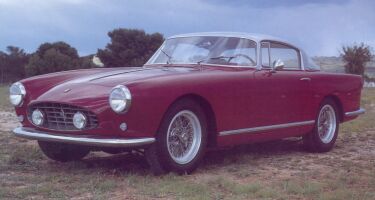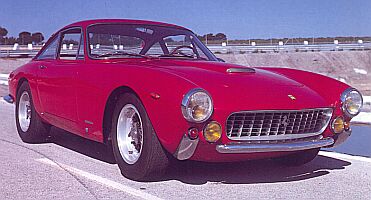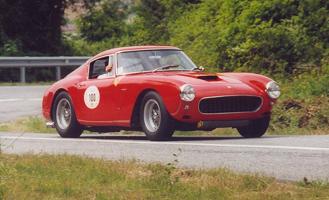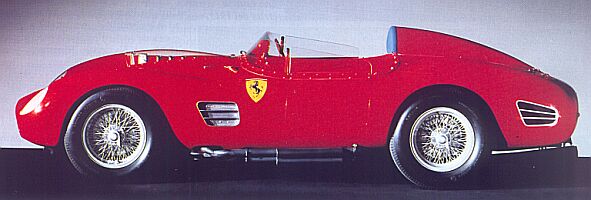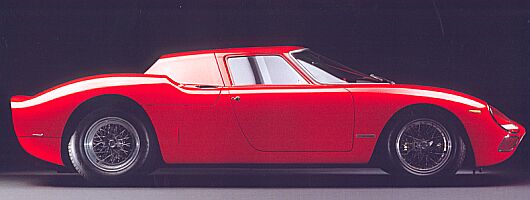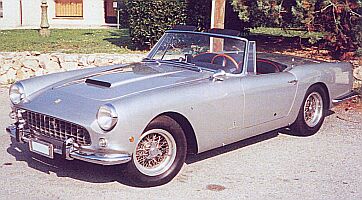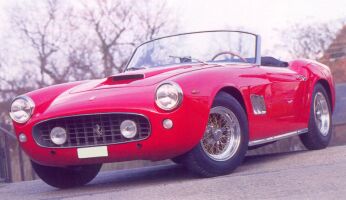The 250 was one of the most significant
cars in the history of Ferrari. The first car built in large (for Ferrari)
numbers, it included in its numerous variants the first production Ferrari
with disc brakes, the first four-seat Ferrari, the first commercially available
mid-engined Ferrari, numerous race and championship winners and of course,
the classic 250 GTO, which is covered on a separate page.
Apart from a few of the more exotic competition
variants (such as the mid-engined 250P) all the cars used the same basic
layout with a longitudinal V12 at the front driving the rear wheels. The
front suspension was independent with double wishbones and coil springs,
whilst at the rear there was a live axle. All the cars had drum brakes
at the beginning, with discs being introduced gradually later.
Unless otherwise noted the engine was a
2953cc V12 with two valves per cylinder, a single overhead camshaft for
each bank of cylinders and dimensions of 73mm x 58.8mm (bore x stroke).
The first cars with the designation '250'
appeared in 1952, the last were produced in 1964.
The early 250's
Emerging in 1952 it used a 2953cc V12 with 230bhp in a 2250mm wheelbase chassis. Both Spider and Berlinetta versions were built.
In May 1952 the Mille Miglia was won by Giovanni Bracco driving an experimental Ferrari 250 S with bodywork by Vignale (modified by Pininfarina) and an engine by Colombo now with 240bhp. The wheelbase was 2400mm, it weighed 850kg (empty) and could achieve 250km/h. Around seventeen coupes and fourteen spiders named the 250MM in honour of this victory were built.
Released at the Paris Motorshow of 1953, with a Lampredi derived engine.
Export produced 220bhp, weighed 800kg and had a 2400mm wheelbase.
Released at the Paris Motorshow of 1953,
with a Lampredi derived 2963cc (68x68mm) V12 engine (220bhp @ 7,000rpm)
it was clothed in a body similar to the bigger capacity 'America' cars.
It weighed 1150kg, had a 2800mm wheelbase and was capable of reaching 218km/h.
A total of 18 examples were built, both
coupes and cabriolets, with bodies by Pininfarina (14 of them) and Vignale.
The 250 GT Coupes
Released at the Paris Motorshow of 1954,
with a 2953cc Colombo derived V12 engine (240bhp) it was built until January 1956.
Around 44 examples of this Pininfarina design were built with a 2600mm wheelbase.
Introduced in 1956, really a second series
GT Europa (with the 'Europa' dropped), it used the same 2953cc development
of the Colombo engine which produced 220bhp @ 7,000rpm.
Still with a 2600mm wheelbase and four
speed (all synchro) box it had a 950-1050kg empty weight. Later a four-speed
plus overdrive box was introduced. Initially fitted with drum brakes all
round, disc brakes became an option and later standard.
After introduction at the Geneva show
in 1956, the first cars were built by Boano (designed by Pinin Farina)
in Turin, around 75 examples. Then around 49 were produced by Ellena from
1957 (previously Boano's partner) with minor differences, such as the deletion
of the quaterlights.
1958 saw the introduction of the Pininfarina 250GT coupe - the main production 250GT with around 343 built. The power went up to 235bhp, whilst wheelbase was the same 2600mm.
Released in 1960 (first seen as the Le Mans course car in that year) this was a Pinin Farina bodied 2+2 coupe (Ferrari's first production four-seater) built on the 2600mm chassis. To improve the internal space the engine (2953cc with 240bhp) was moved forward. A total of 950 cars were built, making it the most produced Ferrari model up until that date.
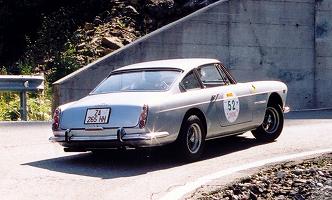 |
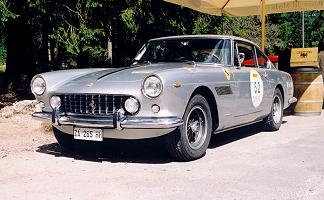 |
The last of the 250 GT cars, the 250 GTL
was introduced at the Paris Motorshow of 1962 using the SWB chassis (2400mm
wheelbase) with a more luxurious trim. Styled by Pininfarina and built
by Scaglietti with steel bodies around 350 were built before the 275GTB
replaced it in 1964. The engine was the same 2953cc unit, in this variant
with 250bhp coupled to a four speed box. Weight 1360kg.
The 250 Sports Cars
250 GT Berlinetta 'Tour de France'
Unofficially named after the victories in the race of that name in 1957, 58 & 59 these were mostly Scaglietti bodied (original design by Pinin Farina) road-going race cars. With the Colombo 3-litre V12 growing in power from 240 to 260bhp in the life of the car.
In 1959 at the Paris Motorshow the 250
GT Berlinetta was introduced with a shorter 2400mm wheelbase. Around 250
were built with bodyshells made from a varying mix of steel and alloy (road
and full-race versions were available) and engines producing from 240 to
280bhp. Many successes were achieved in numerous competitions.
Appearing in 1958, the 250TR used the 250GT engine (2953cc with 290bhp @ 7,500rpm), the 290MM chassis (2350mm wheelbase and 800kg) and the original Testarossa bodywork. Variants used various engines ranging from 300 to 320bhp and including a 2962cc (85x87mm) unit and a fuel-injected unit. The original car used drum brakes, these were later substituted by discs.
Four of the conventional 750 Monzas were fitted with 240bhp 2953cc V12 Colombo engines.
Built for the 1963 Le Mans 24H, the 250P (for Prototipo) was a mid-engined race-car with the 2953cc engine (here with 300bhp @ 7,800rpm). It won. The wheelbase was 2400mm and the empty weight 840kg.
It was November 1963 and at the Paris Motorshow
Ferrari displayed their new mid-engined car, the 250LM. This had been seen
earlier that year in pure racecar form as the Le Mans winning 250P. After
the first few cars with 3-litre engines had been built the remainder (around
30) were fitted with 3.3-litre units (3286cc, 77x58.8mm) with 320bhp @
7,700rpm, but the name never changed. The suspension was independent all
round with double wishbones, the wheelbase was 2400mm and disc brakes and
rack-and-pinion steering also featured
Click here for a picture of the engine and rear suspension of a 250LM.
The open-topped 250 GT's
At the Geneva Motorshow of 1957 Pininfarina
released their cabriolet version (around 36 built on the standard 2600mm
chassis), later joined by a Spider Competitzione with various go-faster
parts. From 1960 (first shown at Paris in 1959) to 1962 they built their
second series cabriolets, around 200 of which were produced. These were
effectively convertible versions of their coupe.
Emerging at the end of 1957, this was a
cabriolet version of the 250GT Berlinetta built by Scaglietti using a steel
body and aluminium bonnet, doors and bootlid. Around 45 were built until
1960 with various levels of engine and using the 2600mm chassis.
At the Geneva Motorshow in 1960 there
appeared a new 250GT Spyder California using the recently released 2400mm
short-wheelbase chassis. Disc brakes also replaced the drums of the previous
model. About 55 of these cars were built until near the end of 1962.
See our picture gallery index for images from museums, motorshows and events. A variety of Ferrari
250s can be seen, especially in the 2001 and 2002 Mille Miglia galleries.
There are also wallpapers/desktop backgrounds of various 250s available to download.
Use the buttons at the top to navigate
further, or
Copyright © 2000 to 2011 CarsfromItaly
